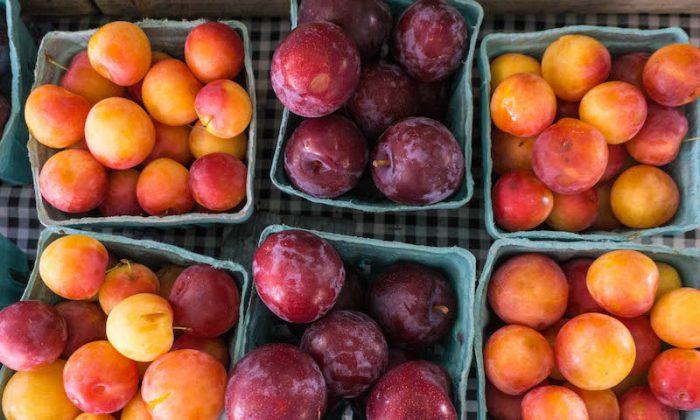NEW YORK—Summer is at its peak, and the markets are teeming with its bounty—fresh, sun-kissed, and bursting with flavor.
On a visit to the Union Square Greenmarket in New York in early August, stone fruits were the star of the show: blushing peaches and nectarines; plums the size of walnuts and up, sweet interiors countered by bracingly tart skins in rosy yellow and lush green and dark red.
Meanwhile, shiny-skinned eggplant abounded, dark purple giants alongside white-and-lavender-striped miniatures, and tomatoes were not to be outdone—multi-colored, multi-sized specimens graced every few stands. An aptly named Sungold burst juicy and sunshine-sweet in my mouth, tinged with a whiff of grassiness. Like summer candy.
Despite intentions of strictly “window” shopping, I found myself leaving with bagfuls of produce: tinier-than-bite-sized Tristar strawberries, an assortment of plums, and baskets of golden and ruby tomatoes still on the vine. All was gone by the next day.
While it’s hard to go wrong with in-season produce, it’s helpful to know what to look for at the market, and how to make the most of your haul at home. In this guide, chefs around the country offer tips about the summer fruits and vegetables they’re most excited about.
Cherries
Meaghan Hurn, owner and luxury consulting chef, Consulting Chef ServicesWhat’s in Season: Cherries are in perfect condition this time of year. Cherry harvest season starts in early May for our California cherries; in June, we start harvesting Washington cherries and continue until the last cherries are picked from high-elevation orchards in late August.
How to Buy: There are two primary varieties of cherries: sweet and tart. Sweet cherries, such as Bing cherries, are best eaten fresh and raw, while sour cherries develop a fuller flavor when they’re used in cooking (which is why they’re often used for baking).
Sweet cherries become firm when ripe (the stems usually stay attached when you pick a sweet cherry), and sour cherries part easily from the stem. Look for heavy, firm cherries with a shiny skin and fresh stem. Cherries that are to be shipped will keep longer if the stems are left attached.
How to Enjoy: If I’m cooking at home, it’s equal parts snacking on them and cooking with them. Usually at the same time. I really prefer a nice, full-bodied cherry sauce with duck or pork tenderloin.
Peaches
Jason Cheek, chef and executive owner, Southern Proper, BostonWhat’s in Season: I’m most excited about peaches right now. Peaches are one of those stone fruits that are only in season for a few months out of the year, usually between late July and early September. At Southern Proper, we are using peaches for several things right now: cocktails, homemade pickles, peach cobbler, baked pies, and grilled in salads. In the winter months, we use the pits for vinegar.
How to Buy: You should be looking for a peach that is a little soft but still has a little bit of a firm feel. Peaches will continue to ripen as time goes on. Do not buy peaches that are tough; they are sour and will most likely over-ripen due to an underdeveloped pit. If you do buy a peach that isn’t ripe, it is great for making pickles.
How to Enjoy: My favorite way to eat a peach is to cut it up in a bowl and mix with a little salt, hot sauce, and honey. This goes perfect with a dry rosé.
Nectarines
Miles Thompson, chef, Michael’s Santa Monica, Santa Monica, CaliforniaWhat’s in Season: I am excited about nectarines right now because they are an incredible, delicious, and unique fruit that has all the things—sugar, acid, juice, and an unbelievably versatile range of applications. Nectarines should be great until mid-September this year, and depending on where you live.
How to Buy: You should look for fruit that is heavy for its size. It should feel firmer than you think a fruit should be, but with a slight give. Do not use your thumb to gauge ripeness. Rather, place the fruit in the palm of your hand with the stem end pointing up and gently close your hand—fingers extended, not curling in—around the fruit. If you feel the fruit yield slightly to the knuckle above the first section of your fingers, it is ready. If you prefer tarter fruit, look for harder specimens; and if you prefer sweeter, then softer.
Good-quality fruit comes from good-quality growers. Talk to the farmers growing it at the market. If they are genuinely excited and passionate about what they do, their fruit will be exceptional. A good nectarine is undamaged, with uniform skin texture (some varieties have speckling so do not be put off by that) and should smell intoxicating.
How to Enjoy: My favorite way to eat a nectarine is either in hand, with a paper towel to catch the juices as I bite into it, or I have this process of cutting abstract chunks (leaving only the flowering end of the fruit attached to the pit) before munching on the bottom end of the fruit around the pit.
Nectarine and Burrata Salad
- Mint-Lemon Verbena Aioli
- 1 burstingly ripe nectarine, cut into abstract bite-sized diamond shapes
- 2 ounces burrata
- Wild arugula
- Lemon juice
- Unfiltered extra-virgin olive oil
- Maldon sea salt
Yields 1 pint
- 1 soft-boiled egg
- 1 cup mint leaves (I prefer to blanch, wring out, and finely chop to prep them)
- 3/4 cup lemon verbena leaves (I prefer to blanch, wring out, and finely chop to prep them)
- 2 tablespoons lemon juice
- 2 cloves of garlic, pasted
- 1 tablespoon Dijon mustard
- 2 tablespoons sugar
- 1/4 cup white wine vinegar
- 1 cup blended oil
- 2 cups chopped parsley leaves
- salt to taste
Slowly drizzle the olive oil into the blender to emulsify.
Once emulsified, add the parsley leaves and puree until smooth.
Remove the aioli to an ice bath and stir continuously until completely cold.
When chilled, store aioli in airtight pint containers under refrigeration.
To Plate:
Smear a healthy dose of the aioli (your preference and to taste) on a plate.
Arrange nectarine pieces over the sauce.
Tear the burrata into strings and lace over the stonefruit.
Delicately dress the arugula with lemon and olive oil, season with Maldon. Top the nectarine and burrata with the dressed arugula. Serve immediately.
Recipe courtesy of Miles Thompson
Tomatoes
David Rotter, executive chef, Boulton and Watt, New York CityWhat’s in Season: Tomatoes, especially heirloom tomatoes, and basil. Tomatoes are in their prime season from mid-July to early September. They’re sweet, juicy, and just ooze summer. I’m a Jersey boy, so for me, a Jersey tomato represents summer.
How to Buy: I look for the perfect balance of firm and soft, and a deep, rich, red skin.
How to Enjoy: There are so many ways to eat a tomato, we could be here forever if I listed them all. My two favorite ways are the most nostalgic ones. My father would prepare simply sliced tomato with a dollop of mayo and cracked black pepper for us kids. It was so good!
The other way is to whip it up in a simple pasta dish that my grandparents used to make. They’d sauté onion, garlic, and chili flakes and then add fresh cherry tomatoes until they were slightly softened. Then they’d toss the mix in pasta with fresh basil and a little pecorino. Pure summer perfection!
My favorite simple summer recipe is to throw fresh-cut heirloom tomatoes, homemade basil pesto, and burrata cheese into freshly cooked pasta. If you don’t have time for homemade ingredients, you can pick up a good pesto, burrata, and pasta at your local store.
Eggplant
Dana Murrell, executive chef, Green ChefWhat’s in Season: I love eggplant, which came into season in the organic realm in early July. Eggplant is one of my favorites because there are so many varieties, it is super versatile, and it cooks rather quickly. Eggplant will only be in season for a few months because it desires a hot, sunny environment and has a long flower-to-fruit timeline.
Secondly, I love summer squash (yellow squash, zucchini, patty pan), because not only is it versatile in savory cuisine, but it can also be used in baking. Summer squash is usually in season a little longer, with the season stretching into late August to early September. The plants are heartier than eggplant and can survive an occasional cold snap better, and the flower to fruit timeline is a bit shorter.
How to Buy: Eggplant should be firm with little to no soft spots. Those soft spots translate to bruises under the peel, which can damage the vegetable. The skin should be shiny and smooth, while the stem should be green. Also, opt for small to medium eggplant as they tend to be less bitter.
For summer squash, they should be firm as well with a rich color on the skin. If you press into the skin with your fingernail and it punctures easily, the squash is immature and likely to bruise easily in your fridge. Rather, if when pierced there is a bit of resistance, the squash is at its peak ripeness. You want to avoid overly large squash as they will be “woody” and have a tough flesh that is not ideal for cooking.
How to Enjoy: For eggplant and summer squash, it isn’t so much about their taste, but rather their texture. I love them because they are so versatile, and part of that is they take on the flavor of what you cook them with so easily. However, a ripe eggplant will be firm when cooked rather than mealy, and if picked at the right time will be savory instead of bitter. Ripe summer squash will also be firm, and in my opinion slightly sweet, which makes the transition from savory to sweet so easily.
There are two ways I love to eat eggplant. One of them takes me back to my childhood when my mother used to spend all day prepping (peeling, cutting, and soaking) the eggplant before breading it and pan-frying it. She would then serve it with some warmed tomato sauce and pasta. This is something I enjoy carrying on into my own family.
The other way I love to eat eggplant is sliced thick, marinated in balsamic dressing, and grilled until tender. This can then be a stand-in for a burger between two buns, or a showstopper on a fresh farmers market salad.
I love zucchini at its purest, seasoned with a little bit of salt and pepper, brushed with a bit of oil, and then grilled until tender. I could eat zucchini like this with every dinner every night. The other way I love to eat zucchini is in a sweet application—zucchini bread! Grated and folded into a quick bread batter, baked, and served warm with some butter or honey is my ideal breakfast.
Melons
Jeff Vucko, chef de cuisine, Travelle Kitchen + Bar, ChicagoWhat’s in Season: I am most excited about melons right now! The early rain in late May and June really got the plants growing fast. Now the saturated soil and warm July sun allowed the deep roots to grow and the melons smell fabulous. They will be in season all of August and slightly into September if the farmers don’t pick them all because of demand for their delicious nectar.
How to Buy: First, how it looks: no bruising, holes, or flies all around them. You want that beautiful shell. Next, pick it up! If it feels dense, almost like a wet towel, surprisingly heavy, it is ready to eat! But the telltale sign is the smell. Put your nose where the stem would have been. If it smells like sweet, sweet honey or like a melon explosion, grab it and buy it as fast as possible.
How to Enjoy: The Green City Market in Chicago has a few varietals of melons currently. I love them all. To start, Korean melon, honeydew melons, watermelon that are red and yellow, and orange-fleshed cantaloupe varietals. They all are amazing by themselves.
If you are looking to keep it simple, wrap them up with something salty, like prosciutto or serrano ham. Cube or ball them up, sprinkle some chili flakes or black pepper on them for that spicy-sweet contrast that I love. Even some lime juice and basil or mint will really enhance everything.
You cannot go wrong with a product that is in season and makes you look like a genius at times. I would like to thank the farmers for giving us this treat and Mother Nature for those heavy rains in late spring.
Okra
Candace Conley, chef and owner, The Girl Can Cook, Tulsa, OklahomaWhat’s in Season: Okra! It is a hot weather crop so it will be growing through September. We are having a bumper crop this year. Lots of beautiful okra.
How to Buy: It should be green with no brown spots, firm to the touch, and at least 2 inches long. It should smell grassy. The smaller pods are more tender than the larger ones (over 3 inches), and for those of us who know okra, the smaller pods are preferred.
How to Enjoy: Okra has a mild flavor and is often used as a “support” vegetable because it takes on flavor well, and because of its thickening properties when it is stewed in gumbos and such.
As far as I’m concerned, the only way to eat it on its own is fried. Frying okra brings out a nutty flavor, and when fried it’s very crispy, like eating popcorn. It is rarely “slimy” when fried properly.
This recipe is a riff on the country-style fried okra that my mother made for years and years. It will always be my favorite. She never deep-fat-fried or battered it. The okra was simply tossed in white cornmeal with salt and cayenne pepper then shallow-fried in Crisco until very crisp.
Oklahoma Fried Okra
Serves 4 as a side, 6 to 8 as a snack
- 1 pound fresh okra, stems removed and sliced lengthwise on the bias
- 1/2 cup white cornmeal
- 1/2 medium Fresno chile, thinly sliced
- 2 tablespoons rendered bacon fat
- 2 tablespoons vegetable shortening
- 2 tablespoons chopped bacon
- Kosher salt, to taste
In a medium sauté pan, heat the bacon fat and vegetable shortening over medium heat until very hot.
Once hot, add the okra and toss until the okra is mostly in one layer in the pan. Add the chile slices and continue to cook and toss until the okra is very crisp and browned.
Season to taste with salt and toss to combine. Sprinkle with chopped bacon. Serve.
Okra is best at room temperature but is also very good the next day, served cold or at room temperature.
Recipe courtesy of Candace Conley
Corn
Michael Han, chef de cuisine, Ortzi, New YorkWhat’s in Season: Sweet corn. I go for the bi-color corn since it is sweet but less starchy. Corn season really picks up in August, probably until October when it starts to slow down. Anything after that is just too cold.
How to Buy: Corn should always come in the husk and the corn silk (the threads at the top) should be brown, not black or dry. I always like to give them a good squeeze to feel for the plump kernels underneath, and the husk should be bright green color (not tan or dry, which are common off-season).
How to Enjoy: Grilled in the husk over charcoals. Melted salted butter with chili flakes and toasted garlic in it. Just a great way to finish up the summer.
Peppers
Keith Potter, chef de cuisine, Cindy’s, ChicagoWhat’s in Season: All the sweet and spicy peppers coming into season now. Shishitos, Cubanelles, Melroses, Lipsticks, Fresnos, and Jalapeños. I love their vibrant colors, all the different flavors and spice levels. [They will be in season] probably until early October.
How to Buy: Look for waxy skinned, firm peppers with a fragrance like spicy/grassy chlorophyll.
How to Enjoy: Roasted in a black steel pan or cast iron pan and roughly chopped or peeled and chopped. Add some Tropea onion, parsley, and olive oil and sherry vinegar. As a relish with some great bread and cheese. [They taste] sweet, hot, and really flavorful. Flavor that is more pronounced when they are roasted or charred.
Figs
Claudette Zepeda-Wilkins, executive chef, El Jardín, San DiegoWhat’s in Season: Figs and stone fruit are my favorites this time of year. Peaches are generally available from May through September in Southern California, and figs are generally available from July to October. Figs feel particularly special because they have such a short season.
How to Buy: For both, the smell is the best way to discern quality. There’s a very distinct sweet scent that figs and peaches produce. Figs smell like honey, and depending on the variety, you can taste lavender notes in the honey [in some], orange in [others]. Peaches smell like summer, with vanilla and honey notes in yellow peaches.
With figs, I wait as long as possible to serve them—the softer, the better. I love peaches that are firm, but with [the] perfect firmness to slice.
How to Enjoy: I’m a purist when it comes to both—I’ll eat them either fresh with nothing on them or roasted and served over crusty sourdough.






